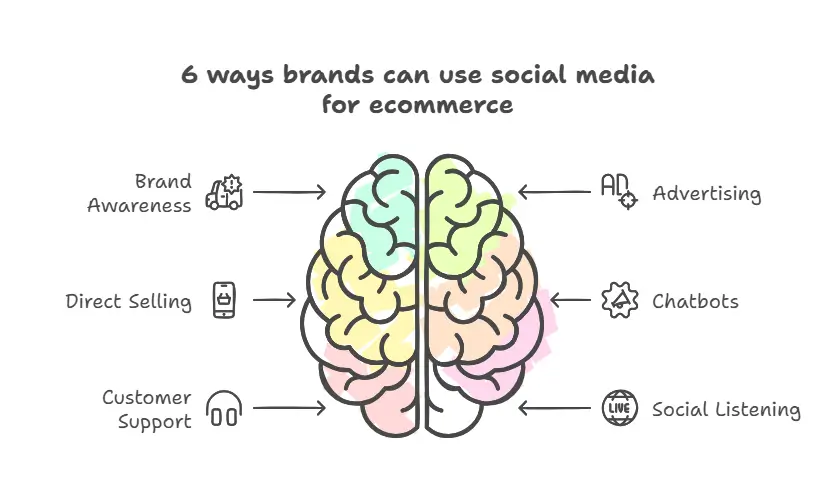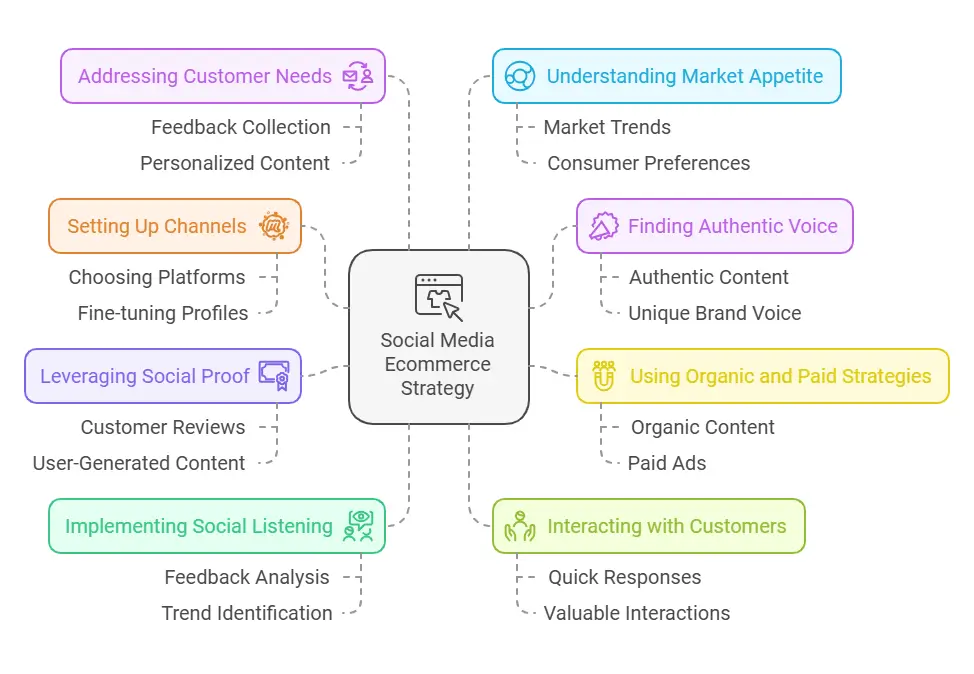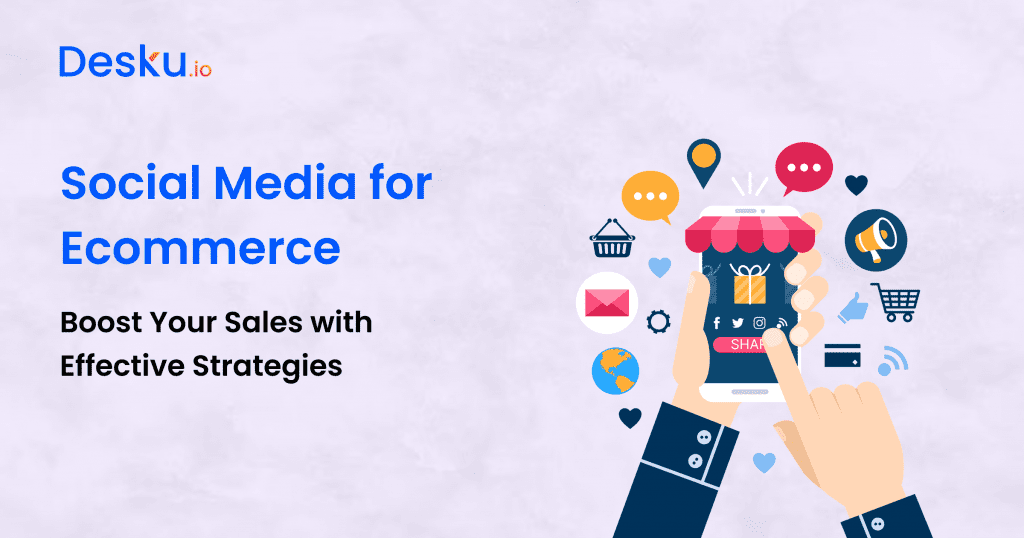Having a hard time getting your ecommerce business noticed amidst the online crowd? Well, the answer is right at your fingertips – social media for ecommerce.
Thanks to its expansive reach and strong marketing features, social media is a great way to ramp up your brand visibility, push more traffic to your site, and ultimately, sell more.
But what’s the best way to use social media for your ecommerce business? That’s what we’re going to chat about.
We’ll be sharing some easy-to-follow marketing strategies and customer service tips that will help your business shine on social media.
So, let’s get started on taking your social media game to new heights and helping your ecommerce business thrive.
The Ultimate Guide to Social Media for ECommerce
If you’re on a mission to broaden the scope of your ecommerce business and ramp up sales, having a solid grasp of social media is a must.
Think of social media as a powerful ally for your ecommerce venture, as it can massively boost your brand’s visibility, create a meaningful rapport with your audience, and pump up your sales.
With a staggering $2.9 trillion predicted in sales via social platforms by 2026, it’s easy to see how social media can be a game-changer for your business.
Social media platforms such as Facebook, Instagram, and TikTok are your gateways to connect with your audience and present your products or services.
These platforms are buzzing with a whopping 4.7 billion users worldwide, which means a huge pool of potential customers at your disposal.
With savvy social commerce methods, you can sell your products directly on these platforms, simplifying the buying process for your customers.
Interacting with customers on social media is a key factor in ecommerce success. By promptly responding to comments, messages, and feedback, you can sway buying decisions in your favor and nurture a band of loyal customers.
Plus, social media can offer you precious market insights, helping you tweak your messages and cater to customer needs more effectively.
6 ways brands can use social media for ecommerce

Hey there! Let’s talk about how your brand can really shine using social media in the ecommerce space.
First things first, let’s make your brand known! You can do this with engaging campaigns, some great discounts, and a whole lot of good, meaningful talks that get people interested.
Then, why not give social media ads a whirl? Platforms like Facebook, Instagram, and the like have a huge user base and some great tools to zero in on your target audience, which can really help get your products seen and sold.
And hey, have you thought about selling straight from these platforms?
Facebook, Instagram, Pinterest, and others have made it super easy to shop right from their apps, creating a smooth and easy experience for your customers.
1. Build brand awareness
Social media – it’s a game-changer for online retailers wanting to get noticed and make an impact. Think about it. Billions of people are scrolling, liking, and sharing on platforms like Facebook, Instagram, and Pinterest every single day. So why not tap into that market?
It’s the perfect space to chat about your products, offer exclusive deals, and really get to know your customers. You can even set up shop right there on the platform, which makes shopping a breeze for your customers. How cool is that?
But it’s not just about selling. It’s also about listening and learning. Keep an eye on what your customers are saying, and use that info to improve your products and services.
It’s a win-win: your customers feel heard, and your brand becomes even better!
And don’t forget about chatbots. They’re like your brand’s personal assistants, helping customers with inquiries and purchases. It’s a quick and easy way to boost sales and customer satisfaction.
2. Advertise
Social media advertising – it’s a big deal these days, and for good reason. Just think about it. Facebook alone has a whopping 2.8 billion people using it every month.
That’s a lot of potential customers for your ecommerce business, right? And the best part? You can tailor your ads to reach exactly the kind of people who are most likely to be interested in your products.
You can target based on things like age, location, interests, even online behavior.
And then there’s Instagram. It’s all about the visuals, and that’s perfect for showing off what you’ve got to sell. You can create a buzz around your products and get people talking – and buying.
Paid social media campaigns are another great tool. You can set specific goals – maybe you want more people to visit your website, or you want to boost your brand awareness.
Then, you can track your progress and tweak things as needed to make sure you’re on the right track.
3. Sell products directly on social media
Isn’t it pretty amazing how social media has evolved? What started as a way to connect with friends and family has turned into a digital marketplace.
Platforms like Facebook, Instagram, and Pinterest are now bustling with businesses selling their products directly to consumers. It’s like having a shop right in the palm of your hand!
These social media platforms have features that make shopping a breeze. Businesses can display their products, interact with potential customers, and even close sales right there on the app.
Shoppable posts and product tags make it easy for you to find exactly what you’re looking for. And the best part? You can check out right in the app!
It’s a win-win for businesses and customers alike. Businesses get to reach more people and boost their sales, while customers enjoy a hassle-free shopping experience.
And let’s not forget about the power of social media. With just a few clicks, a business can reach millions of potential customers.
4. Increase sales with an ecommerce chatbot
Chatbots in the world of ecommerce can really give your sales a boost while adding a touch of sparkle to the online shopping experience.
Let’s highlight the top five ways these handy chatbots can ramp up sales and deliver top-tier customer service:
- Always available customer help: Picture a world where assistance is available round the clock. Chatbots make this possible by quickly addressing customer questions and concerns at any time of day.
- Custom product suggestions: Picture a world where your shopping assistant knows exactly what you like. Chatbots, with their knack for technology, can suggest products based on your tastes and past browsing behavior.
- Quick handling of queries: Chatbots have the ability to handle customer questions swiftly and guide them step by step through the buying process.
- Swift replies: A chatbot integration can speed up response times. This, in turn, boosts customer happiness and leads to more sales.
- Smooth online shopping: Chatbots can make online shopping effortless by offering on-the-spot help and guiding customers through the entire buying journey.
5. Customer support
Hey, did you know that social media is a gold mine for brands when it comes to customer support? It’s true! If you’re a brand, you can use social media platforms to engage with your customers in a more personal way.
Imagine this. A customer posts a query or a complaint about your product. Instead of waiting for days for an email response, they get a direct reply from you on the same platform. How cool is that? Not only does it make the customer feel valued, but it also helps you solve their issues faster.
But wait, there’s more. Social media is also a great place to collect feedback. Let’s say you’ve launched a new product, and you’re curious about what your customers think. Just look at the comments and messages on your post. They’ll tell you what’s working and what’s not. You can then use this information to make your product even better.
And it doesn’t stop there. You can also use social media to keep a tab on what your customers need. Platforms like Twitter and Instagram can be great places to find out what your customers are talking about, what issues they’re facing, and what they’re looking for.
And the best part? Doing all this can help you build a strong community around your brand. Your customers won’t just be customers, but loyal fans. And this, my friend, can do wonders for your brand’s reputation. So go ahead, use social media to take your customer support game to the next level. Trust me, you won’t regret it.
6. Social listening
Let’s have a chat about how businesses can really tap into the magic of social media for their ecommerce success. Have you heard of social listening? This nifty practice lets businesses keep an eye on online chatter, understand how their customers feel, and pick up on important feedback that could make their ecommerce offerings even better.
Here’s a quick rundown of five ways businesses can get the most out of social listening for their ecommerce game plan:
- It gives you a window into what your customers like and what’s trending
- It can help flag potential issues that could throw a spanner in your ecommerce plans
- There are cool tools out there that can help you keep tabs on how your audience is interacting with your brand
- It can help you make smarter choices by looking at past data and reports
- It keeps you on your toes, understanding what your competitors are up to and how consumers are behaving.
And that’s just the tip of the iceberg. Social listening really is a game changer for ecommerce.
How to create a social media ecommerce strategy

If you’re looking to get your ecommerce business buzzing on social media, here’s a way to do it. Kick off by getting your ecommerce presence up and running on popular platforms like Instagram, Facebook, and TikTok. Try to find that genuine voice that makes you, well, you. That’s how you stand out from the crowd on social media.
Mix it up with both organic and paid tactics to get the most reach and engagement. And hey, don’t forget to show off a little! Share content made by your users and their testimonials to win over your audience’s trust. And of course, always keep an ear to the ground – understand what your customers want and need. This will help you tailor your content and strategies to them.
1. Set up social ecommerce channels
Establishing social ecommerce channels on well-known platforms such as Instagram, Facebook, and TikTok is a key step in connecting with a broad audience and boosting sales. So, how can you build an effective social media ecommerce plan? Here are some pointers:
- Picking the right platforms: It’s all about knowing where your audience hangs out and what kinds of products they’re interested in. So, choose the social media platforms that match with your intended audience and product offerings.
- Fine-tuning your profiles: Make sure your social media profiles are filled out with all the necessary details. Also, don’t forget to use keywords and hashtags to help people find you more easily.
- Producing compelling content: Aim to make content that’s genuine and engaging, something that will strike a chord with your audience and let your brand’s personality shine through.
- Including clear prompts: Keep your posts clear and concise, and make sure to link directly to your product pages. This way, the shopping experience is smooth and effortless for your customers.
- Making the most of paid advertising: Don’t shy away from using paid advertising on social media platforms. It’s a great way to boost visibility and extend your reach.
2. Find your authentic voice & be unique
Hey there, let’s chat about two key ingredients you need to spice up your social media ecommerce game – authenticity and uniqueness. What’s that about? Well, think about it this way. Your brand’s voice is its personality, its vibe. It’s what makes people trust you, believe in you. It’s what makes your brand, well, your brand. It’s like a fingerprint – unique and distinct. And that’s exactly what you want your brand to be – memorable and different.
Because let’s be honest, the ecommerce world is packed, right? You have to stand out. You have to be that one-of-a-kind brand that people remember, that they talk about. And that’s where being unique comes in. It’s about creating content that’s different, that’s fresh, that shakes things up a bit. It’s about making your brand stick in people’s minds.
And guess what happens when you do all this? People connect with your brand. They engage with it. They become loyal to it. And that’s huge. Because when people feel connected to your brand, they’re more likely to buy from you.
3. Use organic and paid strategies
Boosting your brand’s visibility and driving customer engagement can be done effectively through a blend of organic and paid strategies. Here’s why this approach is a smart move:
- Broadening your audience: Regularly posting and sharing content from your users can help you connect with more people and build a strong reputation for your brand.
- Ads that hit the bullseye: With paid methods, you can send your message to a very specific set of people, making sure it lands with those who’ll appreciate it the most.
- Team up with influencers: Working with influencers can extend your brand’s reach and earn the trust of their followers.
- Increase visits to your site: A mix of organic and paid methods can guide customers to your ecommerce site and boost actual sales.
- Make the most of your budget: A balanced approach between organic and paid strategies allows for smart budget allocation and a greater return on your investment.
4. Use social proof
Including social proof in your social media ecommerce strategy will really help to build your brand’s reputation. You know, things like customer reviews, testimonials, and content created by users are a massive help.
They not only increase interaction but also sway people’s buying choices. It’s been shown that 88% of buyers view online reviews with the same level of trust as personal recommendations.
To put it simply, social proof is key to winning over your customers.
Showing off satisfied customers and their experiences can definitely help to ease any doubts potential buyers might have.
It’s also a great way to encourage conversions on social media. Have you ever thought about presenting case studies or success stories? It’s a brilliant way to show how your products or services have positively impacted real people’s lives.
Doing this will build a strong relationship with your audience and help to increase sales and brand loyalty. So why not give it a shot?
5. Use social listening
Social listening is like having your ear to the ground in the online world. It’s all about keeping an eye on the chatter about your brand or industry. This way, you can really get to know your customers and what they’re feeling. Here are five things you’ll get out of it:
- You’ll get to know what your customers want and need
- You’ll be able to spot new trends and demands in the market
- You’ll be aware of what your competitors are up to
- You’ll be able to improve your products and services using feedback from customers
- You’ll be able to make better strategic decisions with all the information you’ve gathered
Tools like Facebook Insights can give you even more information about how your audience behaves and their buying patterns.
By making social listening part of your ecommerce plan, you’ll be able to make the most of your social media efforts and make your customers even more satisfied.
6.Interact more with customers
Hey there! Let’s talk about how chatting more with your customers on social media can really boost your ecommerce business.
It’s not just about selling products, it’s about establishing a relationship with your audience. When you connect with customers and show them you’re genuinely interested in their feedback, they feel valued.
Quick response to your customers’ questions or problems? That shows you’re committed and transparent, and it builds trust.
Plus, you’ll get a lot of valuable information from these interactions. You’ll learn about your customers’ tastes and needs, and you can use that info to fine-tune your marketing plans and product line.
There are some great tools out there that can help you keep track of what your customers are saying about you. By using these, you can really refine your approach.
7.Address customer needs
Connecting with your customers on various social media platforms is a key element in crafting a thriving ecommerce strategy. This strategy should focus on meeting customer needs and fostering a strong sense of brand loyalty.
Here are some practical ways to accomplish this:
- Make use of tools that allow you to keep tabs on what people are saying on social media. This can help you pick up on their likes, dislikes, and any issues they may have.
- Be sure to answer any customer questions or comments on your social media posts as quickly as possible. This can make your customers feel heard and valued.
- Make an effort to collect feedback from your customers. This can help you tweak your products, better your services, and make sure your marketing is resonating with your audience.
- Try to personalize your content and any deals or promotions you run. Doing so can increase your sales and strengthen your customers’ loyalty to your brand.
- Use social media not just as a marketing tool, but also as a means to gain a deeper understanding of your customers. This can help you shape your future marketing tactics.
8.Understand market appetite
So, you’re looking to create a strategy for your social media ecommerce, right? Well, you’re going to want to get a real feel for what the market is hungry for.
Let’s put it this way: you wouldn’t host a dinner without knowing what your guests like to eat, would you? That’s where examining market trends and understanding what your consumers are into comes in.
You know those tools that let you eavesdrop on social media conversations? Yeah, those can give you a peek into what people are saying about your industry, the products you offer, and even your competition. It’s like being a fly on the wall in a room full of potential customers.
Collecting this information can help you shape your content and messaging to match what the market is craving. This will make sure your strategy hits the right notes with potential customers.
Think about what you want to achieve based on what the market is telling you and what your audience needs.
When you tap into the market’s appetite, you’re setting up your social media ecommerce strategy to encourage interaction, get people to convert, and most importantly, make those sales.
Examples of social media ecommerce
Hey there! I want to share some cool examples of businesses who are really knocking it out of the park with social media ecommerce.
Have you heard of Solo Stove, WallyGrow, or Spikeball? They’re all brands that have mastered the art of selling their products on social media.
What’s their secret? Well, they’re all about creating engaging content and promoting their stuff with videos.
They also love hosting giveaways and teaming up with influencers. It’s a recipe for success that drives up their sales and gets their brand name out there.
1. Solo Stove

Have you heard about Solo Stove? It’s a top-notch outdoor fire pit and camping stove brand that’s really making waves on social media. Their Instagram game is strong – full of amazing outdoor lifestyle photos that just pull you in. Here’s a look at what they’re doing:
- Real people, real experiences: Instead of relying on professional photoshoots, Solo Stove turns to its own customers for content. This lets them show off how people are really using their products and gives a sense of authenticity to their brand.
- Show and tell through video: Solo Stove knows that a picture is worth a thousand words. But a video? That’s priceless. They use videos to highlight the features of their products and show them in action. It’s a great way to help potential buyers visualize how Solo Stove products can level up their outdoor adventures.
- Building a community: Solo Stove goes above and beyond just selling products. They engage with their followers through giveaways and interactive posts, creating a sense of community and fostering loyalty among their customers.
- Awe-inspiring Instagram feed: One look at Solo Stove’s Instagram and you’ll be itching to get outside. Their stunning visuals not only catch the eye but also inspire followers to live the outdoor lifestyle that Solo Stove promotes.
- Telling a tale: Solo Stove uses their social media to spin a story of adventure, relaxation, and connection. It’s a smart way to connect with their audience on a deeper level and inspire them to become brand advocates.
2. WallyGrow

Hey there, have you heard about WallyGrow? They’re doing some pretty cool stuff over on social media. If you’re into gardening or just love beautiful plants, you should totally check out their Instagram and TikTok. They share some really creative videos of their unique planters and gardening solutions. It’s not just about selling products though, they’re all about building a community and connecting with their audience.
They often have these fun giveaways and get some pretty popular influencers involved. It’s really helped them get their name out there and grow their customer base. And guess what? It’s working! More people are seeing their brand and they’re selling more products.
One thing that’s really cool about WallyGrow is how authentic they are. Their social media doesn’t feel like a sales pitch. Instead, it’s more about sharing their love for plants and helping others discover how fun and rewarding gardening can be.
They do this through engaging content and influencer partnerships, and it’s helping them build a loyal, engaged audience. So yeah, if you love plants as much as they do, you should definitely give WallyGrow a follow.
3. Spikeball

Spikeball sure knows how to play the social media game! Their knack for connecting with customers online and boosting their product sales is seriously impressive. They’ve got some awesome methods that really do the trick:
- They’re all over Instagram and TikTok, reaching out to loads of people
- They host cool giveaways that get people talking and ramp up excitement for their products
- They share thrilling videos of their products in use that keep viewers hooked
- They put out content that clicks with their target audience – it’s like they’re speaking their language!
- They’re always coining new ways to make more people aware of their brand and to ramp up their sales3
FAQs
What are effective strategies to boost ecommerce sales through social media?
Use social media ads, enable in-app shopping, engage with your audience, and track performance metrics to optimize campaigns and drive sales.
How can I effectively engage with my audience on social media to drive ecommerce growth?
Quickly respond to comments, encourage user-generated content, and use interactive posts like polls and live videos to connect with your audience.
What role does social commerce play in modern ecommerce strategies?
Social commerce allows users to shop directly within apps, simplifying the buying process and increasing conversions.
How can I measure the success of my social media ecommerce strategies?
Track KPIs like engagement rates, conversion rates, traffic, and ROI to evaluate and refine your social media efforts.
What are common challenges in implementing social media strategies, and how can they be overcome?
Challenges like time management and content creation can be resolved with scheduling tools and content calendars, while keeping up with trends ensures strategies stay relevant.
Conclusion
Leveraging social media for ecommerce presents a significant opportunity to enhance brand visibility, engage with a broader audience, and drive sales. By implementing effective strategies such as building brand awareness, utilizing social commerce features, engaging with customers, and analyzing performance metrics, businesses can navigate the dynamic social media landscape successfully. Overcoming common challenges through proper planning and the use of appropriate tools further contributes to the effectiveness of social media strategies in the ecommerce sector.


